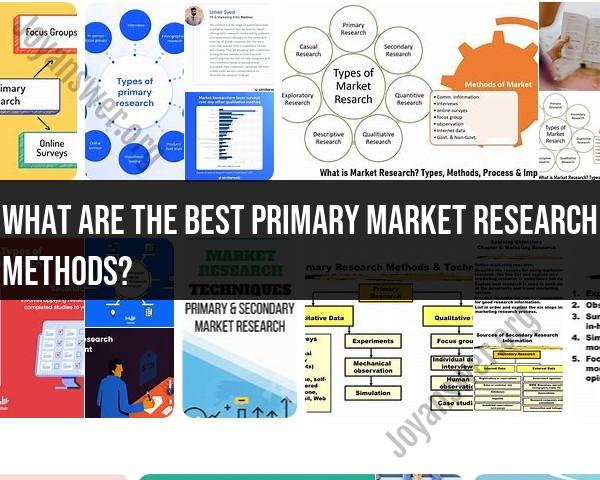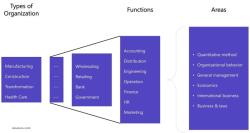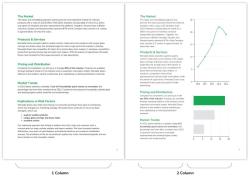What are the best primary market research methods?
The choice of primary market research methods depends on your specific research goals, target audience, and available resources. Different methods can provide valuable insights into your market, customers, and competition. Here are some of the best primary market research methods:
Surveys: Surveys are a popular method for collecting quantitative data. You can use online, telephone, or in-person surveys to gather information from a large sample of respondents. Design well-structured questionnaires to elicit insights on customer preferences, satisfaction, demographics, and more.
Interviews: Conducting one-on-one interviews with individuals or small groups can provide in-depth qualitative data. This method allows you to explore complex topics and gain a deeper understanding of customer needs, motivations, and behaviors.
Focus Groups: Focus groups bring together a small, diverse group of participants to discuss and provide feedback on a product, service, or concept. It's useful for exploring opinions, attitudes, and perceptions.
Observation: Direct observation involves watching and recording how people behave or interact with products or services in a natural setting. This method can be useful for understanding user behavior and identifying pain points or opportunities for improvement.
Ethnographic Research: Ethnography involves immersing researchers in the environment or community being studied. This method is often used for understanding cultural nuances, behaviors, and social context.
In-Depth Customer Interviews: These interviews go beyond general market research and focus on a smaller number of key customers or stakeholders. They can provide insights into customer pain points, preferences, and experiences.
Online Communities and Social Media Listening: Monitor online forums, social media platforms, and community discussions to gather insights on customer sentiment, trends, and feedback related to your industry or products.
A/B Testing: In a controlled online environment, you can test different variations of a product or marketing strategy to see which one performs better. A/B testing allows you to make data-driven decisions.
Usability Testing: This method involves observing users as they interact with a product or website. It helps identify usability issues and provides insights into user behavior and preferences.
Prototype Testing: Test early-stage product or service prototypes with potential customers to gather feedback on design, functionality, and user experience.
Pilot Studies: Conduct small-scale trials of a product or service to identify and address any issues before a full-scale launch. Pilot studies can reveal user reactions and uncover areas for improvement.
Mystery Shopping: In retail and service industries, mystery shoppers act as customers to evaluate the quality of service and the customer experience.
Diaries and Journals: Participants maintain diaries or journals to record their thoughts, experiences, and behaviors over time. This approach provides insights into daily routines, habits, and decision-making processes.
Competitive Analysis: Analyze your competitors' products, marketing strategies, and customer interactions to identify strengths, weaknesses, and opportunities.
Expert Panels: Consult industry experts, consultants, or thought leaders to gain insights and predictions about market trends, innovations, and challenges.
The choice of research method should align with your research objectives and budget. Often, a combination of several methods is the most effective approach to gain a comprehensive understanding of your target market and customers. It's also important to consider the ethical aspects of your research, including obtaining informed consent and protecting participant privacy when applicable.
Primary Market Research Methods: A Comprehensive Guide
Primary market research is the process of collecting data directly from your target market. This can be done through a variety of methods, including surveys, interviews, focus groups, and observation. Primary market research is an important tool for businesses of all sizes, as it can help you better understand your customers, identify new market opportunities, and develop successful marketing campaigns.
Effective Techniques for Gathering Primary Market Data
There are a number of different techniques that can be used to gather primary market data. The most appropriate technique will vary depending on your specific research goals and budget. Some common techniques include:
- Surveys: Surveys are a popular method for gathering primary market data because they are relatively inexpensive and easy to administer. Surveys can be conducted online, in person, or over the phone.
- Interviews: Interviews are a more in-depth method for gathering primary market data, as they allow you to get more detailed feedback from participants. Interviews can be conducted in person, over the phone, or using video conferencing.
- Focus groups: Focus groups are a good way to gather feedback from a small group of people on a specific topic. Focus groups are typically conducted in person and led by a moderator.
- Observation: Observation is a method for gathering primary market data without interacting with participants. Observation can be used to study customer behavior, such as how customers interact with products or services in a retail setting.
Choosing the Right Primary Research Methods for Your Business
When choosing the right primary research methods for your business, it is important to consider the following factors:
- Your research goals: What do you hope to learn from your research?
- Your budget: How much money do you have to spend on research?
- Your target market: Who are you trying to reach with your research?
- Your timeline: How quickly do you need to get results?
Once you have considered these factors, you can choose the primary research methods that are most appropriate for your business.
Benefits of Primary Market Research
There are a number of benefits to conducting primary market research, including:
- Better understand your customers: Primary market research can help you better understand your customers, their needs, and their wants. This information can be used to develop better products and services, create more effective marketing campaigns, and improve customer service.
- Identify new market opportunities: Primary market research can help you identify new market opportunities and trends. This information can be used to develop new products and services, expand into new markets, and stay ahead of the competition.
- Develop successful marketing campaigns: Primary market research can help you develop more successful marketing campaigns. By understanding your customers and their needs, you can create marketing messages that resonate with them.
- Make better business decisions: Primary market research can help you make better business decisions. By understanding your customers, your market, and your competitors, you can make informed decisions about where to allocate your resources and how to grow your business.
Conclusion
Primary market research is an important tool for businesses of all sizes. By conducting primary market research, you can better understand your customers, identify new market opportunities, and develop successful marketing campaigns. If you are looking to grow your business, primary market research is a good place to start.
Here are some additional tips for conducting successful primary market research:
- Make sure your research questions are specific and measurable.
- Use a representative sample of your target market.
- Collect data in a way that is unbiased and accurate.
- Analyze your data carefully and draw meaningful conclusions.
- Share your research findings with your team and use them to make better business decisions.











